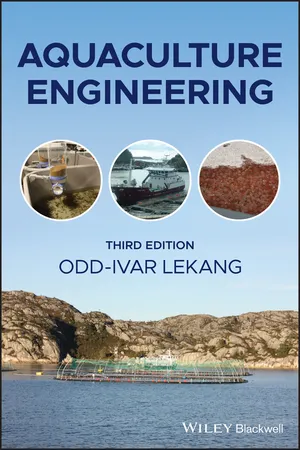
- English
- ePUB (mobile friendly)
- Available on iOS & Android
Aquaculture Engineering
About this book
The revised edition of the comprehensive book that explores the principles and applications of aquaculture engineering
Since the publication of the first edition of Aquaculture Engineering there have been many advances in the industry. The revised and thoroughly updated third edition of Aquaculture Engineering covers the principles and applications of all major facets of aquaculture engineering and the newest developments in the field. Written by a noted expert on the topic, the new edition highlights information on new areas of interest including RAS technology and offshore fish farming.
Comprehensive in scope, the book examines a range of topics including: water transportation and treatment; feed and feeding systems; fish transportation and grading; cleaning and waste handling; instrumentation and monitoring; removal of particles; aeration and oxygenation; recirculation and water reuse systems; ponds; and the design and construction of aquaculture facilities. This important book:
- Presents an updated review of the basic principles and applications in aquaculture engineering
- Includes information on new areas of focus; RAS technology and offshore fish farming
- Contains a revised edition of the classic resource on aquaculture engineering
- Continues to offer an authoritative guide written by a leading expert in the field
Written for aquaculture scientists and managers, engineers, equipment manufacturers and suppliers, and biological scientists, the third edition of Aquaculture Engineering is the authoritative guide to the topic that has been updated to include the most recent developments in the industry.
Frequently asked questions
- Essential is ideal for learners and professionals who enjoy exploring a wide range of subjects. Access the Essential Library with 800,000+ trusted titles and best-sellers across business, personal growth, and the humanities. Includes unlimited reading time and Standard Read Aloud voice.
- Complete: Perfect for advanced learners and researchers needing full, unrestricted access. Unlock 1.4M+ books across hundreds of subjects, including academic and specialized titles. The Complete Plan also includes advanced features like Premium Read Aloud and Research Assistant.
Please note we cannot support devices running on iOS 13 and Android 7 or earlier. Learn more about using the app.
Information
1
Introduction
1.1 Aquaculture engineering
1.2 Classification of aquaculture
1.3 The farm: technical components in a system
- Production units
- Water transfer and treatment
- Additional equipment (feeding, handling and monitoring equipment).
1.3.1 Land‐based hatchery and juvenile production farm
- Water inlet and transfer
- Water treatment facilities
- Production units
- Feeding equipment
- Equipment for internal fish transport and size grading
- Equipment for transport of fish from the farm
- Equipment for waste and wastewater treatment
- Instrumentation and monitoring systems.

Water inlet and transfer
Water treatment facilities
Table of contents
- Cover
- Table of Contents
- Preface
- 1 Introduction
- 2 Water Transport
- 3 Water Quality and Water Treatment: An Introduction
- 4 Fish Metabolism, Water Quality and Separation Technology
- 5 Controlling pH, Alkalinity and Hardness
- 6 Removal of Particles: Traditional Methods
- 7 Protein Skimming, Flotation, Coagulation and Flocculation
- 8 Membrane Filtration
- 9 Sludge
- 10 Disinfection
- 11 Heating and Cooling
- 12 Gas Exchange, Aeration, Oxygenation and CO2 Removal
- 13 Removal of Ammonia and Other Nitrogen Connections from Water
- 14 Recycling Aquaculture Systems: Traditional Recirculating Water Systems
- 15 Natural Systems, Integrated Aquaculture, Aquaponics, Biofloc
- 16 Production Units: A Classification
- 17 Egg Storage and Hatching Equipment
- 18 Tanks, Basins and Other Closed Production Units
- 19 Ponds
- 20 Sea Cages
- 21 Feeding Systems
- 22 Internal Transport and Size Grading
- 23 Transport of Live Fish
- 24 Instrumentation and Monitoring
- 25 Buildings and Superstructures
- 26 Design and Construction of Aquaculture Facilities: Some Examples
- 27 Planning Aquaculture Facilities
- Index
- End User License Agreement